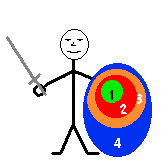 |
Shields do not add to your DDF; instead they subtract from your enemy's skill level.
| Shield Type | Diameter | Adjustment to Skill |
| Target Shield (Buckler) | 1-1.5 | Parry Only: No Adjustment |
| Normal Shield (Small) | 1.6-2.5 | -1 to Skill Level |
| Full Shield (Medium) | 2.6-3.5 | -2 to Skill Level |
| Wall Shield (Tower) | 3.5+ | -3 to Skill Level |
 |
Due to the way Wound Factors work (unlike HP's), we have had to fudge around (sorry!) with a way to run
fire damage. This is something that I didn't realize till a certain Babu opened a trapped
chest...
Damage is rolled using #dF and is cumulative. For every turn you are on or in contact with fire you
roll some fudge dice.
The first turn you are on/in fire roll 2dF
The second turn roll 3dF
The third turn roll 4dF and so on...
(A turn is Five seconds if not in combat)
A negative result or a Zero means there is no damage this turn. But the next positive result will add to the previous amounts.
This is not how dragon fire or combat fire spells (fireball, fire bolt, etc.) are handled, unless you start on fire... They will be talked about in the next section.
Daxis has just jumped into a burning building to save some children from certain doom. He lands on the second floor, after barely leaping through the open window, to be greeted by a fiery falling ceiling support beam falling on him. Daxis is unable to dodge it while he regained his balance, and it crashes into his back setting his clothing ablaze. The first turn 2dF is rolled with a result of +1, so Daxis receives a Scratch. He tries to budge the beam but just doesn't have the leverage.
The second turn of his fire exposure; 3dF is rolled and the result is +3, for a total of +4. Daxis is Hurt. He again tries to force the burning lumber off of him, but the -1 from the Hurt result hinders him. Turn Three. 4dF are rolled and a +2 is the result, a total of +6 a Very Hurt. Dax is wondering if it was such a bright idea leaping up here in the first place and why don't these kids hook up some winch and pulley system.
Combat spells work just like other spells with a minor exception. The caster still states what
spell he/she is casting, what it looks like, and what other stuff they normally do, but they also set the amount of damage done by the spell (see table below).
| Points of Damage | Level Needed to Cast Said Spell |
| 1 | Fair |
| 2 | Good |
| 3 | Great |
| 4 | Superb |
| 5 | Superb +1 |
| 6 | Superb +2 |
| 7 | Superb +3 |
| 8 | Superb +4 |
| 9 | Superb +5 |
| 10 | Superb +6 |
| And so on... |
Note: Armor Does Not defend against magic attacks of this type. Unless of course the
armor was magic also. Shields work as they do in regular combat, magic or not.
Magic Items that cast combat spells (Wands of Force, etc.) always do the same damage (i.e. they have a
predetermined damage level.) In order to manipulate a magic item, use your current ego and Magic
Potential (MP) levels (e.g.. good ego "+1" and +2 levels of MP=superb) as your skill level with that
item.
Due to some player comments that were made, regarding the written movement, I decided to break the combat round into sections.
| 1. Movement: Write down and reveal moves and actions. |
| 2. Cast Spells: Casting of any Magic (including items), no movement while casting, but once the casting is over with, you may move one hex |
| 3. Spell Effects: Whatever was to happen, happens |
| 4. Missile Weapon Attacks: Missile users can move 1/2 and still attack |
| 5. Melee Weapon Attacks: Melee weapon users can move all and still attack |
Due to the fact everything in combat is somewhat concurrent and spontaneous, what order things happen in isn't a big deal. So all combat is revealed starting from the GM's left around the table and back to the GM.
We've also added some rules governing engagement and something called "quick attacks". We think both will be worth while additions.
Engagement:When two combatants are face to face (in each others front hexes) they are engaged. They are not both engaged if one is not in the others front, (e.g. I'm attacking Arafa from behind. I can strike at will but Arafa can't do anything to me, so I can just walk away whenever I like. He's engaged with me but I'm not engaged with him.)
There are about three ways to disengaging a adversary: agreeing to end the fight, making a suitable roll to vacate the combat (agility, dodge, leaping, etc.) or taking out your opponent.
Larger scale creatures are engaged by 0 scale opponents equal to their scale bonus. Smaller than 0 scale beings are engaged only by their own scale. Scale 0 is engaged by more than one scale -1 opponent or another scale 0 opponent. Standard multiple opponents rules apply still.
If at anytime someone walks next to a combatant (in their front hexes) either of them have the option of a "quick attack", a unplanned maneuver. There is a -1 to both participants rolls due to spontaneity;once the attack is complete both parties may, if they choose, proceed to their original goals. If one of the fighters doesn't want to waste their action they don't have to roll, but instead take it as a unopposed roll.
 I'll see you
in the War Room.
I'll see you
in the War Room.